|
ERETZ Magazine
|
Stayput Western
Galilee
The Western Galilee is the
epitome of a Galilean landscape: Green mountains covered with
beautiful Mediterranean forests extending all the way down into the
sea, beautiful beaches, ancient towns, and hidden mountain villages.
The Galilee is not a large region. A mere 100 kilometers separate
its northern border – the peak of Mount Hermon – from its
southernmost boundary along the Jezreel Plain, the site of biblical
Armageddon. Its eastern reaches, on the far edge of the Golan
plateau, lie only 70 kilometers from the Mediterranean Sea in the
west. But these 7,000 square kilometers encompass amazingly
beautiful and contrasting scenery: mountains and valleys; fertile
plateaus and stark cliffs; and a glimmering seacoast.
Not only is it a drive of just one hour from one end of the Galilee
to the other, but it is also a short hop from major attractions all
around Israel: a two-hour drive to Tel Aviv, under three hours to
Jerusalem or the Dead Sea.
But what makes the Galilee an outstanding travel destination is more
than its scenery or convenience. This is a region where it is
possible to trace the long ascent of man from his early beginnings
to what he has become today. Prehistoric skeletons found in the
Galilee show that in this place, man developed the ability to speak.
Here, too, man made the transition from hunter and gatherer to
farmer – and the very first permanent villages were erected.
Six thousand years ago, the Galilee was already bustling with human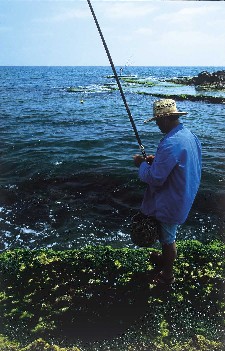 activity. The natural forests that covered Galilee mountains were
cleared and replaced with farms and villages. On the plains, large
cities sprung up. About 4,000 years ago, Hazor, of biblical fame,
was a world-famous trading center.
activity. The natural forests that covered Galilee mountains were
cleared and replaced with farms and villages. On the plains, large
cities sprung up. About 4,000 years ago, Hazor, of biblical fame,
was a world-famous trading center.
Some 3,500 years ago, Joshua and the Israelite tribes conquered the
Galilee and settled there, side by side with the pagan indigenous
population. The haunting mountains of the Galilee were the abode of
Elijah, the greatest of all biblical prophets. Later on, the Galilee
became the home of the elusive “men of deeds” – Jewish healers and
miracle workers. Jesus came from the Galilee, as did Peter, Andrew,
John, and Bartholomew.
The Galilee mountains were the birthplace of Jewish mysticism.
Shimon bar Yochai, regarded as the first Jewish mystic, lived in the
Galilee in the second century CE. In the sixteenth century, the
small town of Safed became the birthplace of Kabbala. The
charismatic Yitzhak Ashkenazi Luria, the Lion of Safed, drew
hundreds of followers. They flocked to the forested mountains of the
Galilee to learn from him how to unravel the mystery of the Godhead.
The Galilee today is still a relatively unknown destination. Its
tourism facilities have developed slowly. But in the past few years,
the hospitality of its people, and the growing worldwide interest in
agro-tourism and eco-tourism, have made the region increasingly
popular. The Galilee as a travel destination is a place to take in
things slowly, a place to sit in the shade of an ancient olive tree,
bask in the sun on a quiet beach, or walk along a cobblestone lane
still echoing with the footsteps of centuries. Its mystical
atmosphere takes the visitor far away from the frenetic world we
live in today.
(Back to top)
Montfort Castle
The castle was originally constructed as a Crusader agricultural
manor, part of the feudal fiefdom of Meiliya. In 1220, the castle
was separated from the fiefdom and sold to the German order of the
Teutonic knights. The Germans fortified the fortress and renamed it
Starkenberg – the strong fortress.
The Teutonic order was not popular with the two established Crusader
orders of the Templars and Hospitallers and so it moved its
headquarters from Acre, where the other orders were located, to
Starkenberg, up in the mountains above Acre. The castle also held
the treasures of the order and its archives.
In 1226, the Moslem sultan, Baybars, attacked the castle. The
attack failed and he was forced to withdraw. Five years later,
Baybars returned.
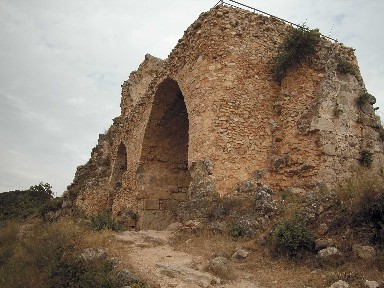 This
time, with a unit of military engineers who managed to undermine the
castle’s walls. After one week, the engineers managed to topple the
southern wall of the outer defenses of the fortress. The knights
withdrew to the inner castle and continued to resist. After a heated
discussion, the knights decided to surrender – on condition that
they would be allowed to leave the fortress for Acre with their
weapons, archive, and treasure. The archive was transferred to
Austria, where it can still be seen today, and the Teutonic knights
sailed away to Europe to become the scourge of Poland and to later
take part in the creation of Prussia. This
time, with a unit of military engineers who managed to undermine the
castle’s walls. After one week, the engineers managed to topple the
southern wall of the outer defenses of the fortress. The knights
withdrew to the inner castle and continued to resist. After a heated
discussion, the knights decided to surrender – on condition that
they would be allowed to leave the fortress for Acre with their
weapons, archive, and treasure. The archive was transferred to
Austria, where it can still be seen today, and the Teutonic knights
sailed away to Europe to become the scourge of Poland and to later
take part in the creation of Prussia.
To get to the fortress entails a 30-minute walk, either from the
Goren park, on the northern bank of Nahal Kziv, or from Meiliya and
Hila. Both the walks lead through the beautiful Mediterranean woods
around the castle. The castle itself, standing on a dramatic spur
above the riverbed of Nahal Kziv, has not been excavated yet But the
ruins are fun to explore with a lot of secret rooms and recesses in
between the growth.
(Back to top)
Where to Eat
The Galilean bistro Aloma has a surprising location – the Arab
village of Tarshiha. The menu is composed of fine French food
created from the raw materials of the Galilee. A great deal of
effort was put into the bistro’s design, which is impressive, yet
innocent. (Tarshiha-Kfar Veredim Road, Tel. (04) 957-4477, not
kosher).
The Morganfeld Steakhouse specializes in roasting meat over
whispering coals. Its menu includes entrecote steak, beef filet, and
asado. Come hungry – one doesn’t find portions of quality meat this
large often (Moshav Liman, Tel. (04) 952-4333, kosher).
Arnold’s is a chef’s restaurant near Kabri Junction. The chef and
owner, Uri Arnon, created a commendable meat menu. Try the milk-fed
veal osso buco, the pullet stuffed with Galilean wheat, or the
excellent steaks (Moshav Nativ Hashayara, Tel. (04) 952-2211,
kosher).
Much has been said about the Adlina restaurant. Some have named it
the best restaurant in Galilee. Its menu includes dishes such as
paella with seafood and a mischievous selection of tapas, including
the option of having nine different tapas for two diners for only
NIS 115 (Kibbutz Kabri, Tel. (04) 952-3707, not kosher).
(Back to top)
Achziv
The little hill that juts out into the sea, with a small secluded
harbor at its foot, has probably been a magnet for fishermen and
traders for millennia. The Phoenicians created a trading city on the
hill, part of their Mediterranean empire. The town is mentioned in
the Bible as part of the realm of the tribe of Asher. The city,
remarks the Bible, was not conquered by the people of Israel. The
Talmud mentions Achziv as a center for the production of the rare
purple dye used by royalty and as a city on the main coastal road
from Tyre to Acre. The Crusaders built a fort on top of the hill and
Sultan Baybars conquered it from the Crusaders in 1271. For the next
700 years, it was a small Moslem fishing village located in the
ruins of the ancient town. Following the War of Independence, the
Arab villagers fled to Lebanon.
In the 1960s, Eli Avivi settled in the ruins, declaring Achziv an
independent state. A few years later, the southern part of the ruins
became a Club Med holiday village and the northern part was turned
into a National Park. Avivi, Club Med, and the park are all there
today – in a site that has some of the best beaches in Israel along
with the best camping ground in Israel.
(Back to top)
Rainbow Cave
Located at the top of the Sulam Range, the cave is the ultimate
viewpoint of the Western Galilee. To get there, take Route 899 from
Betzet Junction, north of Nahariya. Follow the road to the junction
for Kibbutz Adamit and turn onto Route 9993 toward Adamit. The road
hairpins up the mountain along Nahal Namer. At the top of the road,
before Kibbutz Adamit, is a road leading to the right to the Keshet
Picnic Site. Follow the road to the parking lot. Take the
green-marked path to the cave. Be careful and don’t allow children
to run around alone. The Rainbow Cave is part of a collapsed cave
popular with mountain climbers. From the cave, a path leads along
the cliff. If you want to hike, take the red-marked trail to the
right (west). It reaches the road at the top of the hairpins. A
driver should take the car back down the road to meet the hikers.
The view from the cave is spectacular: The whole northern coastline,
all the way to Haifa, and the mountains of Galilee.
(Back to top)
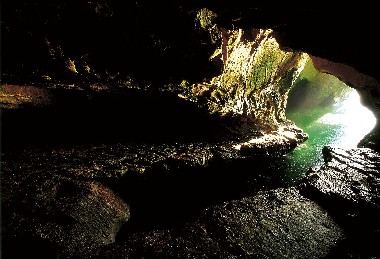
Itinerary
Day 1: Western Galilee
Take 89 to the west, towards the coast. At Nahariya, take Route 4
south to Acre and explore the Crusader town. Drive north on Route 4
to Kibbutz Lohamei Hagetaot and visit the ghetto fighters museum.
Continue north to Rosh Hanikra for a visit to the grottos. Return
south on Route 4 to Achziv for a swim in the Mediterranean (May to
November).
(Back to top)
Day 2: Upper Galilee
Drive along Route 89 to the east. After the Druze town of
Hurfeish, take the road to the right to the summit of Mount Meron.
Walk along the summit path (40 minutes) for a view of the Galilee.
Drive back to Route 89 and continue to Safed. Explore the city of
the Kabbalists. Drive to Rosh Pina and explore the old village. End
with dinner at one of the many restaurants in Rosh Pina.
(Back to top)
Day 3: Sea of Galilee
Take Route 89 east to Hosen Junction. Drive along the scenic
Route 864 to Rama. Take Route 85 to the east, and at its end turn
right onto Route 90. At the Capernaum Junction, follow 87 along the
northern shore of the lake. This is the area where most of the
events mentioned in the New Testament took place – Tabgha, with its
beautiful mosaic, Capernaum, the home of Peter, with its massive
synagogue, and more. Cross the Jordan and drive to the junction with
Route 92. Take Route 92 past Kursi, the site of the miracle of the
Gerasene Demoniac, to Ein Gev for lunch. Continue south to Deganiya
for a visit to the Old Deganiya Courtyard, where the first kibbutz
was founded. Continue around the lake to the southern entrance to
Tiberias, where you will find the tomb of Rabbi Meir Baal Haness and
the ancient synagogue of Hamat Tiberias with its beautiful mosaic.
(Back to top)
Day 4: The Galilee Panhandle
Take Route 89 east to the Hiram Junction just after Kibbutz Sasa.
Turn left onto the road to the Baram synagogue. Continue to the
junction to Rehaniya and turn right toward Rehaniya. At the end of
the road, turn left onto Route 886 and drive through some of the
most scenic landscapes of the Galilee on the way to Ramot Naftali.
Take Route 899 down to Route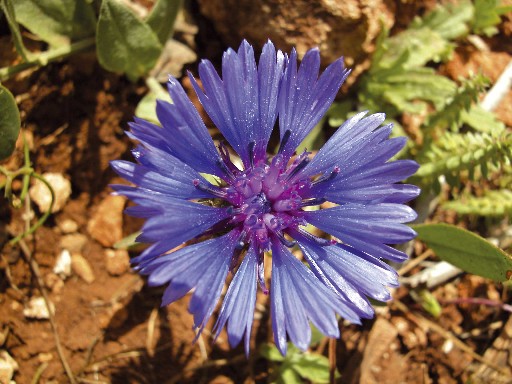 90. Drive a kilometer and a half to the south, and turn off into the
Hula Agamon – an attempt to revive the Hula Swamp. After a jaunt
with the thousands of wild fowl at the swamp, return to Route 90 and
drive north to Kiryat Shemona. Take Route 99 to the Dan Nature
Reserve to visit one of the sources of the Jordan River and the
biblical tell of Dan. Now retrace a little on Route 90 to the
junction with Route 918 – take it all the way south, through the
Hula Valley and some of the lushest countryside in Israel to its end
at Mishmar Hayarden. Take Route 91 west back to Route 90. Follow the
road to the junction with Route 85 and drive back to the hotel.
90. Drive a kilometer and a half to the south, and turn off into the
Hula Agamon – an attempt to revive the Hula Swamp. After a jaunt
with the thousands of wild fowl at the swamp, return to Route 90 and
drive north to Kiryat Shemona. Take Route 99 to the Dan Nature
Reserve to visit one of the sources of the Jordan River and the
biblical tell of Dan. Now retrace a little on Route 90 to the
junction with Route 918 – take it all the way south, through the
Hula Valley and some of the lushest countryside in Israel to its end
at Mishmar Hayarden. Take Route 91 west back to Route 90. Follow the
road to the junction with Route 85 and drive back to the hotel.
(Back to top)
Day 5: Jerusalem
Drive to Jerusalem by taking Route 89 to 4 and from there take 2
to Route 1. Enter the Old City via the Jaffa Gate and visit the
Tower of David Museum on the history of Jerusalem. Walk down David
Street, the main souvenir market. Turn left onto Christian Quarter
Street and walk to the alley of Saint Helena that leads down to the
Holy Sepulcher. Exit by the doorway to the Muristan Market and walk
straight ahead until you reach the busy market street of Khan e-Zeit.
Turn right and walk down the Crusader markets. Once out of the
market make your way to Sisileh Street. Walk down to the Kotel. Take
the Rabbi Yehudah Halevi steps up to the Jewish Quarter. Walk to the
Zion Gate. Once out of the gate, turn right, and go to the Jaffa
Gate.
(Back to top)
Day 6: Tel Aviv
Take Route 89 to Nahariya. Take 4 to Haifa and 2 to Tel Aviv.
Explore Jaffa. Stroll through historic Tel Aviv at Neve Tzedek and
Rothschild Boulevard. Have lunch on Sheinkin Street and check out
the shops along Dizengoff Street. End the day with dinner on Ibn
Gabirol Street.
(Back to top)
Hacienda Forestview Hotel
The Hacienda Forestview is the only hotel that was harmed in the
Second Lebanon War. As a result, its owners invested heavily in
renovating the hotel after the war ended. In addition to a beautiful
spa, complete with a Turkish hamam and fitness center, and acres
upon acres of natural forest, the hotel is noteworthy for its
cuisine. The renovations included the kitchen, where Chef Gil Segal
was brought in to develop a varied, healthy, and tasty spa menu. The
huge breakfast that is served daily includes more than a few gems,
such as the extensive selection of homemade jams. Dinners are
especially festive; the rich smell of meat that was slowly cooked in
earthen pits or roasted just outside the dining room adds to the
atmosphere. The 140 spacious, luxurious guestrooms are spread out
over almost 20 acres of land, providing guests with privacy and the
opportunity to luxuriate in nature. Several of the rooms are
designed to accommodate the disabled, with wider doorways for
wheelchairs and similar features. The newest guestrooms are the
garden rooms with jacuzzis in their center and are highly
recommended.
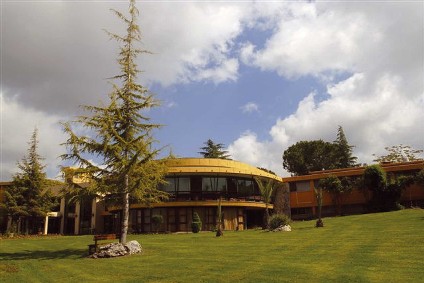
(Back to top)
|
|